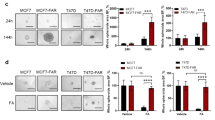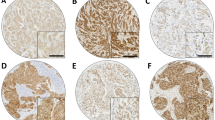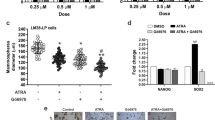Abstract
An inverse relationship between protein kinase C (PKC) activity and oestrogen receptor (ER) expression in human breast cell lines and tumours has been firmly established over the past 10 years. To determine whether specific alterations in PKC expression accompany hormone-independence, we examined the expression of PKC isozymes in the hormone-independent human breast cancer cell clones MCF-7 5C and T47D:C42 compared with their hormone-dependent counterparts, MCF-7 A4, MCF-7 WS8 and T47D:A18 respectively. Both hormone-independent cell clones exhibit elevated PKCα expression and increased basal AP-1 activity compared with the hormone-dependent cell clones. To determine whether PKCα overexpression is sufficient to mediate the hormone-independent phenotype, we stably transfected an expression plasmid containing PKCα cDNA to the T47D:A18 and MCF-7 A4 cell lines. This is the first report of PKCα transfection in T47D cells. In contrast to MCF-7 cells, T47D has the propensity to lose the ER and more readily forms tamoxifen-stimulated tumours in athymic mice. We find that in T47D:A18/PKCα clones, there is concomitant up-regulation of PKC βI and δ, whereas in the MCF-7 A4/PKCα transfectants PKC ɛ is up-regulated. In T47D:A18, but not in MCF-7 A4, PKCα stable transfection is accompanied by down-regulation of ER function whilst basal AP-1 activity is elevated. Our results suggest PKCα overexpression may play a role in growth signalling during the shift from hormone dependent to hormone-independent breast cancers. © 2000 Cancer Research Campaign
Similar content being viewed by others
Article PDF
Change history
16 November 2011
This paper was modified 12 months after initial publication to switch to Creative Commons licence terms, as noted at publication
References
Angel P and Karin M (1991) The role of Jun, Fos and the AP-1 complex in cell-proliferation and transformation. Biochim Biophys Acta 1072: 129–157
Angel P, Baumann I, Stein B, Delius H, Rahmsdorf HJ and Herrlich P (1987a) 12-O-tetradecanoyl-phorbol-13-acetate induction of the human collagenase gene is mediated by an inducible enhancer element located in the 5′-flanking region. Mol Cell Biol 7: 2256–2266
Angel P, Imagawa M, Chiu R, Stein B, Imbra RJ, Rahmsdorf HJ, Jonat C, Herrlich P and Karin M (1987b) Phorbol ester-inducible genes contain a common cis element recognized by a TPA-modulated trans-acting factor. Cell 49: 729–739
Astruc ME, Chabret C, Bali P, Gagne D and Pons M (1995) Prolonged treatment of breast cancer cells with antiestrogens increases the activating protein-1-mediated response: involvement of the estrogen receptor. Endocrinology 136: 824–832
Borner CR, Wyss R, Regazzi RUE and Fabbro D (1987) Immunological quantitation of phospholipid/Ca2+-dependent protein kinase of human mammary carcinoma cells: inverse relationships to estrogen receptors. Int J Cancer 40: 344–348
Catherino WH and Jordan VC (1995) Increasing the number of tandem estrogen response elements increases the estrogenic activity of a tamoxifen analogue. Cancer Lett 92: 39–47
Chen TK, Smith LM, Gebhardt DK, Birrer MJ and Brown PH (1996) Activation and inhibition of the AP-1 complex in human breast cancer cells. Mol Carcinog 15: 215–226
Davidson N and Kennedy M (1996) Protein kinase C and breast cancer. In: R D). and M, L. (eds) Mammary tumor cell cycle, differentiation and metastasis pp. 91–105. Kluwer Academic Pubishers.
Dekker LV and Parker PJ (1994) Protein kinase C–a question of specificity. Trends Biochem Sci 19: 73–77
Dumont JA, Bitoni AJ, Wallace CD, Baumann RJ, Cashman EA and Cross-Doersen DE (1996) Progression of MCF-7 breast cancer cells to antiestrogen-resistant phenotype is accompanied by elevated levels of AP-1 DNA-binding activity. Cell Growth Differ 7: 351–359
Encarnacion CA, Ciocca DR, McGuire WL, Clark GM, Fuqua SA and Osborne CK (1993) Measurement of steroid hormone receptors in breast cancer patients on tamoxifen. Breast Cancer Res Treat 26: 237–246
Gordge PC, Hulme MJ, Clegg RA and Miller WR (1996) Elevation of protein kinase A and protein kinase C activities in malignant as compared with normal human breast tissue. Eur J Cancer 32A: 2120–2216
Hata A, Akita Y, Suzuki K and Ohno S (1993) Functional divergence of protein kinase C (PKC) family members. PKC gamma differs from PKC alpha and -beta II and nPKC epsilon in its competence to mediate-12-O-tetradecanoyl phorbol 13-acetate (TPA)- responsive transcriptional activation through a TPA-response element. J Biol Chem 268: 9122–9129
Jiang SY, Wolf DM, Yingling JM, Chang C and Jordan VC (1992) An estrogen receptor positive MCF-7 clone that is resistant to antiestrogens and estradiol. Mol Cell Endocrinol 90: 77–86
Johnson MD, Torri JA, Lippman ME and Dickson RB (1999) Regulation of motility and protease expression in PKC-mediated induction of MCF-7 breast cancer cell invasiveness [In Process Citation]. Exp Cell Res 247: 105–113
Johnston SR, Haynes BP, Sacks NP, McKinna JA, Griggs LJ, Jarman M, Baum M, Smith IE and Dowsett M (1993) Effect of oestrogen receptor status and time on the intra-tumoural accumulation of tamoxifen and N-desmethyltamoxifen following short-term therapy in human primary breast cancer. Breast Cancer Res Treat 28: 241–250
Johnston SR, Lu B, Scott GK, Kushner PJ, Smith IE, Dowsett M and Benz CC (1999) Increased activator protein-1 DNA binding and c-Jun NH2-terminal kinase activity in human breast tumors with acquired tamoxifen resistance. Clin Cancer Res 5: 251–256
Karnik PS, Kulkarni S, Liu XP, Budd GT and Bukowski RM (1994) Estrogen receptor mutations in tamoxifen-resistant breast cancer. Cancer Res 54: 349–353
Kazanietz MG, Areces LB, Bahador A, Mischak H, Goodnight J, Mushinski JF and Blumberg PM (1993) Characterization of ligand and substrate specificity for the calcium-dependent and calcium-independent protein kinase C isozymes. Mol Pharmacol 44: 298–307
Labarca C and Paigen K (1980) A simple, rapid, and sensitive DNA assay procedure. Anal Biochem 102: 344–352
Lee W, Mitchell P and Tjian R (1987) Purified transcription factor AP-1 interacts with TPA-inducible enhancer elements. Cell 49: 741–752
MacGregor Schafer J, Lee ES, O’Regan RM, Yao K and Jordan VC (2000) Rapid development of tamoxifen-stimulated mutant p53 breast tumors (T47D) in athymic in mice. Clin Cancer Res,
Manni A, Buckwalter E, Etindi R, Kunselman S, Rossini A, Mauger D, Dabbs D and Demers L (1996a) Induction of a less aggressive breast cancer phenotype by protein kinase c-α and -β overexpression. Cell Growth & Differentiation 7: 1187–1198
Martin MB, Garcia-Morales P, Stoica A, Solomon HB, Pierce M, Katz D, Zhang S, Danielsen M and Saceda M (1995) Effects of 12-O-tetradecanoylphorbol-13-acetate on estrogen receptor activity in MCF-7 cells. J Biol Chem 270: 25244–25251
Morse-Gaudio M, Connolly JM and Rose DP (1998) Protein kinase C and its isoforms in human breast cancer cells: relationship to the invasive phenotype. Int J Oncol 12: 1349–1354
Ng T, Shima D, Squire A, Bastiaens PI, Gschmeissner S, Humphries MJ and Parker PJ (1999) PKCalpha regulates betal integrin-dependent cell motility through association and control of integrin traffic. Embo J 18: 3909–3923
Nishizuka Y (1992) Intracellular signaling by hydrolysis of phospholipids and activation of protein kinase C. Science 258: 607–614
Nordeen SK (1988) Luciferase reporter gene vectors for analysis of promoters and enhancers. Biotechniques 6: 454–8
O’Brian C, Vogel VG, Singletary SE and Ward NE (1989) Elevated protein kinase C expression in human breast tumor biopsies relative to normal breast tissue. Cancer Res 49: 3215–3217
Osborne CK (1993) Mechanisms for tamoxifen resistance in breast cancer: possible role of tamoxifen metabolism. J Steroid Biochem Mol Biol 47: 83–89
Philips A, Chalbos D and Rochefort H (1993) Estradiol increases and anti-estrogens antagonize the growth factor-induced activator protein-1 activity in MCF7 breast cancer cells without affecting c-fos and c-jun synthesis [published erratum appears in J Biol Chem 1993 Dec 5;268(34):26032]. J Biol Chem 268: 14103–14108
Pink JJ, Jiang SY, Fritsch M and Jordan VC (1995) An estrogen-independent MCF-7 breast cancer cell line which contains a novel 80-kilodalton estrogen receptor-related protein. Cancer Res 55: 2583–2590
Pink JJ, Bilimoria MM, Assikis J and Jordan VC (1996) Irreversible loss of the oestrogen receptor in T47D breast cancer cells following prolonged oestrogen deprivation [published erratum appears in Br J Cancer 1997;75(10):1557]. Br J Cancer 74: 1227–1236
Platet N, Prevostel C, Derocq D, Joubert D, Rochefort H and Garcia M (1998) Breast cancer cell invasiveness: correlation with protein kinase C activity and differential regulation by phorbol ester in estrogen receptor-positive and -negative cells. Int J Cancer 75: 750–756
Reifel-Miller AE, Conarty DM, KM V, PW I, DJ B and KA B (1996) Protein kinase C isozymes differentially regulate promoters containing PEA-3/12-O-tetradecanoylphorbol-13-acetate response element motifs. J Biol Chem 271: 21666–21671
Saceda M, Knabbe C, Dickson RB, Lippman ME, Bronzert D, Lindsey RK, Gottardis MM and Martin MB (1991) Post-transcriptional destabilization of estrogen receptor mRNA in MCF-7 cells by 12-O-tetradecanoylphorbol-13-acetate. J Biol Chem 266: 17809–17814
Smith LM, Wise SC, Hendricks DT, Sabichi AL, Bos T, Reddy P, Brown PH and Birrer MJ (1999) cJun overexpression in MCF-7 breast cancer cells produces a tumorigenic, invasive and hormone resistant phenotype. Oncogene 18: 6063–6070
Sun XG and Rotenberg SA (1999) Overexpression of protein kinase Calpha in MCF-10A human breast cells engenders dramatic alterations in morphology, proliferation, and motility [In Process Citation]. Cell Growth Differ 10: 343–352
Tonetti DA and Jordan VC (1995) Possible mechanisms in the emergence of tamoxifen-resistant breast cancer. Anticancer Drugs 6: 498–507
Tonetti DA, Horio M, Collart FR and Huberman E (1992) Protein kinase C beta gene expression is associated with susceptibility of human promyelocytic leukemia cells to phorbol ester-induced differentiation. Cell Growth Differ 3: 739–745
Ways DK, Kukoly CA, deVente J, Hooker JL, Bryant WO, Posekany KJ, Fletcher DJ, Cook PP and Parker PJ (1995) MCF-7 breast cancer cells transfected with protein kinase C-alpha exhibit altered expression of other protein kinase C isoforms and display a more aggressive neoplastic phenotype. J Clin Invest 95: 1906–1915
Webb P, Lopez GN, Uht RM and Kushner PJ (1995) Tamoxifen activation of the estrogen receptor/AP-1 pathway: potential origin for the cell-specific estrogen-like effects of antiestrogens. Mol Endocrinol 9: 443–456
Wolf DM and Jordan VC (1994) The estrogen receptor from a tamoxifen stimulated MCF-7 tumor variant contains a point mutation in the ligand binding domain. Breast Cancer Res Treat 31: 129–138
Wolf DM, Langan-Fahey SM, Parker CJ, McCague R and Jordan VC (1993) Investigation of the mechanism of tamoxifen-stimulated breast tumor growth with nonisomerizable analogues of tamoxifen and metabolites. J Natl Cancer Inst 85: 806–812
Wyss R, Fabbro D, Regazzi R, Borner C, Takahashi A and Eppenberger U (1987) Phorbol ester and epidermal growth factor receptors in human breast cancer. Anticancer Res 7: 721–727
Author information
Authors and Affiliations
Rights and permissions
From twelve months after its original publication, this work is licensed under the Creative Commons Attribution-NonCommercial-Share Alike 3.0 Unported License. To view a copy of this license, visit http://creativecommons.org/licenses/by-nc-sa/3.0/
About this article
Cite this article
Tonetti, D., Chisamore, M., Grdina, W. et al. Stable transfection of protein kinase C alpha cDNA in hormone-dependent breast cancer cell lines. Br J Cancer 83, 782–791 (2000). https://doi.org/10.1054/bjoc.2000.1326
Received:
Revised:
Accepted:
Published:
Issue date:
DOI: https://doi.org/10.1054/bjoc.2000.1326
Keywords
This article is cited by
-
Protein Kinase C Alpha (PKCα) overexpression leads to a better response to retinoid acid therapy through Retinoic Acid Receptor Beta (RARβ) activation in mammary cancer cells
Journal of Cancer Research and Clinical Oncology (2020)
-
Protein kinase C α enhances migration of breast cancer cells through FOXC2-mediated repression of p120-catenin
BMC Cancer (2017)
-
Protein kinase C inhibitor chelerythrine selectively inhibits proliferation of triple-negative breast cancer cells
Scientific Reports (2017)
-
Protein Kinase A-induced tamoxifen resistance is mediated by anchoring protein AKAP13
BMC Cancer (2015)
-
Protein kinase C and cancer: what we know and what we do not
Oncogene (2014)



